4
The Silent Preacher:
Martin Eisengrein and Our Lady at Altötting
The Catholic resurgence that began in Bavaria and in Germany's princely bishoprics in the 1560s achieved stunning successes during the course of the following century. By the conclusion of the Thirty Years War in 1648, approximately one-third of the lands lost to Protestantism had been officially reconverted to Catholicism. State power and imperial politics were certainly factors in this renewal. But in an age when governmental authority was habitually weak, Counter-Reformation princes and clerics fused force and prohibition with a massive propagandistic campaign designed to convince and confirm. In this offensive, the notion of the Roman religion as an unbroken heritage punctuated and proven by miracles provided state and church officials with a powerful appeal. Vitriolic disputes, polemical preaching and printing, the perceived threat of political insurrection, iconoclasm, and religious wars—all these came after the rise of the Reformation. In assessing the contemporary situation, therefore, many found the idea of following time-honored practices justified by supernatural sanction to be more appealing than the new departures of sola fide and sola scriptura , which seemed to produce only controversy and bitterness.
Protestant theologians and preachers recognized the allure of custom and precedent as well, and from the days of Luther's earliest teaching the reformers had argued that they were not departing from tradition but, rather, restoring it to its pristine state. The charge was to ring increasingly hollow in the late sixteenth century as the numbers of various, competing Protestant ideologies swelled. Within Lutheranism alone, disputes over the Eucharist, justification, prebaptismal exorcism, and the issue of "indifferent things," or adiaphora , multiplied following Luther's death in 1546. The clamor only increased in volume when Calvinism entered the empire.
An "illicit" religion according to the Peace of Augsburg settle-
ment of 1555, the Genevan reformation gained its first German foothold in the small but powerful Palatine Electorate. In 1563, the Rhenish elector Frederick III violated the terms of the peace by adopting the Heidelberg Catechism. Soon the relatively puritanical doctrines of this reformed religion were being promoted in the dynasty's various holdings throughout the empire. One of these territories, the Upper Palatinate, lay directly north and northwest of Bavaria. Here the new ecclesiastical leadership initiated a war on popular "superstition," discouraging religious beliefs and practices that were not explicitly of biblical origin. Calvinist officials and ministers were not concerned only with ridding the territory of such traditions as prebaptismal exorcisms, high altars, and religious art; they sought the complete moral reformation of their congregations. And in their offensive they attacked some of the oldest cultural features of the region.
The enthusiasm with which the Calvinists labored can be gleaned from their efforts to modify traditional death customs. To purge the territory of its funerary "unrighteousness," they razed charnel houses and abolished chantries. Ordinances forbade those attending the sick from carrying candles, crosses, and rosaries, objects that traditionally were used to ward off the influence of the poor souls from purgatory and demons who fought at the deathbed over the fate of the dying. To transform the funeral into a rite of familial piety, officials insisted that corpses—widely believed to be polluting—be kept at home until being conveyed to the cemetery. They drastically shortened the period between death and burial and required that each household in a village send one mourner to the graveside, a duty traditionally shunned because of the danger lurking at the moment of interment. The ringing of bells, the use of perpetual lights on graves, and the circuitous procession that the family made with the corpse to the cemetery—similarly believed to protect against evil spirits—were all prohibited as well.[1]
In the Upper Palatinate especially, these extreme attempts to eradicate age-old customs condemned the Calvinist reformation to unpopularity. Both Lutheran and Catholic beliefs and practices re-
[1] See Walter Hartinger's study of death practices during the Reformation and Counter-Reformation in the Upper Palatinate: ... Denen Gott genad! Totenbrauchtum und Armen-Seele-Glaube in der Operpfalz (Regensburg, 1979), pp. 16-21, 36-42.
mained firmly entrenched; indeed, the survival of the latter helped to pave the way for the recatholicization of the territory in the early 1600s.[2] For three centuries, the Calvinist ascendancy survived in the folklore of the region as a brief yet terrifying cataclysm.[3]
At the same time Calvinist moral police were waging their assault in the Upper Palatinate, a very different kind of reformation was under way in the neighboring duchy of Bavaria. Like the movement endorsed by the Palatine electors, the Counter-Reformation in the Wittelsbach territory bore the inspiration and imprint of state authority. At its inception, though, this Catholic effort was not against traditional beliefs and practices; rather, the aim was to appropriate them along with the emotional appeal inherent in the idea of traditio and so defend the Roman Church, its sacraments, and its ceremonial rites. In place of the Protestant vision of the church as an institution to be organized according to the unchanging terms of scripture, Bavaria's counter-reformers juxtaposed their own notion of the true Church as itself a visible text that was constantly developing, assisted by providential guidance. Nevertheless, at the center of this Catholic tradition were certain unchanging rites, such as the seven sacraments, and a variety of benedictory formulae, prayers, and customs, all of which had been blessed by God, as testified by miracles. Touring countryside and towns, figures like Johann Nass proclaimed the miraculous nature of the Roman tradition, and through the publication of printed pamphlets these men attempted to broaden their address to the literate minority. The state-supported production of martyrologies also endeavored to rehabilitate the saints as repositories of supernatural power. Finally,
[2] Robert Döllinger, Das Evangelium in der Oberpfalz (Neuendettelsau, 1952), pp. 60-70; and Johann B. Götz, "Die große oberpfälzische Landesvisitation unter dem Kurfürsten Ludwig VI" (pt. 1), Verhandlungen des Historischen Vereins für Oberpfalz und Regensburg 85 (1935): 148-244. One Calvinist official from the Rhineland Palatinate charged with supervising the reforms was actually murdered by a crowd of townspeople at Tirschenreuth, and the culprits were allowed to escape; see Johann Brunner, "Die Ermorderung des kurfürstlicher Stiftshauptmanns Valentin Winsheim zu Tirschenreuth a. 24. Feb. 1592," Verhandlungen des Historischen Vereins für Oberpfalz und Regensburg 80 (1930): 173-199.
[3] Tales of church desecration and iconoclastic attacks worked by Calvinists survived in the region long after its recatholicization. A nineteenth- and early twentieth-century Catholic almanac, for example, frequently included these legends to pious effect when it treated various villages and churches throughout the Upper Palatinate. See Sulzbach Kalendar für katholische Christen (Sulzbach, 1840-), 1848:82-84, 1857:84-89, 1872:69-70.
the amplification and resurgence of traditional feasts like Corpus Christi advertised the Roman Church and the Wittelsbach state as two pillars of authority that mediated and distributed the supernatural presence of the Eucharist to the laity.
In a conservative society like Bavaria, the appeal to tradition and miracles could be a powerful means of reviving enthusiasm for the Catholic Church. But to be truly effective, tradition could not be confirmed only in terms of wonders worked and recorded in the past. To convince those who still doubted the efficacy of the ancient rites, contemporary miracles needed to be proclaimed and promoted so that traditio could be seen as a continuous legacy and a living, dynamic principle. In the late sixteenth century, therefore, Bavaria's counter-reforming clergy turned once again to publicizing contemporary miracles. Most Bavarians could not read the statements that poured from the Catholic presses at the time, nor was the resurgence inherent in the new rites of Church and state visible to all. Most people lived far from the urban centers where brilliant orators like Johann Nass preached their sermons. But through proclamation at local pilgrimage shrines, publication in modest pamphlets, and oral circulation, the dramatic testimony of neighbors and countrymen provided a continuing confirmation of the praesentia of the Catholic Church.
Although Protestant attacks had discouraged for a time the appeal of local shrines, the fundamental living conditions that had once nourished the popularity of the saints had not changed. Despite the Reformation's stated objectives, even Lutheran pastors had been unable to prevent the borrowing of medieval notions of sanctity and intercession by practitioners of their reformed religion. Social and demographic realities—the ever-present specter of disease, famine, and epidemic, the lack of insurance, and the instability caused by crime and accidents—gave the saints a powerful and enduring role. Protestantism may have devalued the traditional saints, yet in popular and elite perceptions alike they retained a fundamental appeal: the ability to address situations in which human justice, economics, and medicine proved inadequate.[4]
[4] A point also made in Thomas, Religion and the Decline of Magic ; and in Brown, Cult of the Saints , p. 63 and passim. An incisive review of Thomas's functionalism appears in Natalie Z. Davis, "Some Tasks and Themes in the Study of Popular Religion," in The Pursuit of Holiness , ed. Charles E. Trinkaus and Heiko A. Oberman (Leiden, 1972), pp. 307-336. Here the application of the functionalist interpretation is not without its problems: it fails, for instance, to explain why belief in the efficacy of the saints had been called into question in the first place. Nevertheless, as a reason for the resurgence of miracles and pilgrimage, its application appears especially warranted. As I have tried to show, Protestant attempts to expunge the cult of the saints failed because no equally compelling explanations for inexplicable phenomena were provided as a replacement. Moreover, there was not one mutually agreed upon "Protestant" attitude toward miracles and the supernatural, but only a confusion of voices; this only compounded the problem.
The counter-reformers astutely sensed that restoring luster to the saints' reputation as wonder-workers was often all that was necessary to revive a particular devotion. Miraculous testimonies were thus one of the first tools Bavarian propagandists used in their attempts to revivify traditional religion and local pilgrimages. The collections of miracles proclaimed and recorded at early modern shrines in Bavaria often grew to incredible lengths, even when compared to the dramatic florescence of the late Middle Ages. Between 1600 and 1800, for example, over 12,000 miracles were recorded at the shrine of Neukirchen bei Heilig Blut;[5] and at Bettbrunn, the clergy may have compiled more than 16,500 accounts for the period 1573-1768.[6] A study by Hermann Bach shows that these collections, prodigious as they are, were not unusual.[7]
Besides these manuscript compilations, the Counter-Reformation clergy renewed the use of printed books to publicize their cults. Two trends typified this revival: a reliance on thin miracle books similar to those published in late medieval Bavaria and, in addition, the appearance of apologetic and theological works designed to defend pilgrimages from Protestant attack and to deepen and discipline the experience of peregrination.
In the century or so before the Counter-Reformation was launched, only three shrines—all Marian pilgrimages—had published the first sort of work. Their precocity in distributing miracle records was due to the devotion's relative novelty within Bavaria: because Marian shrines often appeared suddenly and inexplicably, they lacked the relics, images, and long traditions of wonder-
[5] Walter Hartinger, "Die Wallfahrt Neukirchen bei heilig Blut: volkskundliche Untersuchung einer Gnadenstätte an der bayerisch-böhmischen Grenze," Beiträge zur Geschichte des Bistums Regensburg 5 (1971): 157ff.
[6] See Alois Döring, "St. Salvator in Bettbrunn: historisch-volkskundliche Untersuchung zur eucharistischen Wallfahrt," Beiträge zur Geschichte des Bistums Regensburg 13 (1977): 175-176.
[7] Bach, "Mirakelbücher bayerischer Wallfahrtsorte."
working and legend-weaving that other sites used to attract the faithful. The printing of miracles thus gave the clergy at these shrines a unique opportunity to promote their cult.[8] With the coming of the Counter-Reformation, however, an increasing number and variety of cults began to use printing to promote their saintly wonders.
At first, these modest miracle pamphlets remained remarkably similar to those published in the late Middle Ages. Their terse formulaic style, modest vocabulary, and simple illustrations allowed them to be cheaply produced, distributed, and purchased by the broadest possible audience in Bavaria. Throughout early modern Catholic Europe, in fact, this literature of contemporary miracles enjoyed a strong appeal. Assessing France, Roger Chartier has termed the miracle pamphlet one component of a "true popular literature," meaning that its audience comprised tradesmen, artisans, and even some peasants, though clerics, patricians, and other burghers would also have read these tracts.[9] In Bavaria, the miracles publicized in these slim volumes continued to exemplify the relationship of exchange between votant and saint, just as the pamphlets from the late Middle Ages had done. Their dependable content and remarkable profusion suggest that for many—probably the majority of those inclined to believe in the power of the saints—the Reformation had had little long-term impact.[10]
But in the 1560s a new class of worshipers was emerging for whom miracles alone would not suffice to justify Bavaria's local shrines. These "diligent laity and clergy," to use Johann Nass's description, had as their goal to understand the deeper, interior meaning of Catholic practices. When this new devotional movement first appeared, its composition was distinctly elite and literate, consisting largely of students at Bavaria's Church schools and the university at Ingolstadt, Wittelsbach officials, highly placed bur-
[8] Josef Staber, "Religionsgeschichtliche Bemerkungen zum Ursprung der Marienwallfahrten in Bistum Regensburg," Beiträge zur Geschichte des Bistums Regensburg 7 (1973): 41-61; and idem, Volksfrömmigkeit und Wallfahrtswesen , pp. 40 and passim.
[9] Roger Chartier, "Publishing Strategies and What the People Read, 1530-1660," in The Cultural Uses of Print in Early Modern France , trans. Lydia G. Cochrane (Princeton, 1987), pp. 145-182; and idem, "The Hanged Woman Miraculously Saved: An Occasionnel ," in Chartier (ed.), Culture of Print , pp. 59-91.
[10] This point is also made by Steven Sargent in "Miracle Books and Pilgrimage Shrines," pp. 470-471.
ghers, and the clerical elite. These pious displayed a fervent devotion to Roman rites and practices from the outset. From the position of the Church hierarchy, however, their zeal also presented a certain danger; for by striving toward the internalization of piety they—like late medieval groups such as the Beguines and Beghards before them—threatened to make superfluous the rites and sacraments of the institutional Church. Certainly, Bavaria's Catholic reformers recognized that the Reformation itself had roots in this piety: the ideas of Erasmus, Luther, and other early Protestant leaders had all, after all, been nurtured in an outpouring of lay and clerical spirituality. In the late sixteenth century, then, Bavaria's Counter-Reformation theologians and clerical officials began to concentrate on institutionalizing the religiosity of the new devout within the structures of the Roman Church (a movement that pious confraternities were eventually to contain and discipline).[11]
Because many of those searching for a deeper piety were also literate, Bavaria's foremost theologians began to produce a new kind of printed work, propaganda in the true, original sense of the term: incorporating apologetic, polemical, and devotional strains, this was a literature intended to revive, define, and discipline the emerging religion of the Catholic Reformation—truly, to propagate the faith. While many in the new devotional movements were drawn from the social, political, and clerical elites of Bavaria, few were well schooled in the traditions of scholastic theology. As a result, the tone of much of this writing is distinctly "middle-brow."
Pllgrimage was one of the first traditional religious practices to receive the special attention of Bavaria's new propagandists, and thanks to their efforts it eventually became an important vehicle for the expression of Catholic religiosity. In the 1560s, the Ingolstadt theologian Martin Eisengrein (1535-1578) published the first of many works aimed at reviving local shrines. These early contributions, which were crucial to the later development of a distinctive peregrinational theology, provide a valuable glimpse at the tactics of Bavaria's clerical hierarchy.
Like most members of the first generation of Counter-Reformation propagandists, Eisengrein was a convert. Born into a wealthy Lutheran family in Stuttgart, he had spent his student years attend-
[11] Chatellier, Europe of the Devout , pp. 14-46.
ing the universities of Tübingen, Ingolstadt, and Vienna. It was in the last city that he converted, sometime in 1558 or 1559, and there he began to study theology. By 1560 he had been ordained a priest and assumed the powerful position of cathedral preacher at the city's St. Stephen's Cathedral. From the start Eisengrein was rigorous in his devotion to Catholic orthodoxy, and he soon became involved in a plan, ultimately unsuccessful, to purge the University of Vienna of its Protestants. His participation in this scheme prepared the way for his move to Bavaria, for at Ingolstadt the rector of the university, Friedrich Staphylus, learned of Eisengrein's efforts and asked Duke Albrecht to invite him to become priest and preacher at the university's St. Moritz parish.[12]
From his arrival in Ingolstadt in 1562 until his death in 1578, Eisengrein dedicated himself completely to the cause of Catholic reform, not just in the university town, but throughout Bavaria. His career exemplifies the blurring that occurred between state and clerical functions as the Wittelsbachs worked to establish their hegemony over religion. Although called to serve as a parish priest, Eisengrein soon joined the theological faculty of the university, and in this capacity he united with other counter-reformers to rid the institution of its Protestants. For his successes in enforcing doctrinal uniformity, the Wittelsbach duke entrusted Eisengrein with a variety of governmental and ecclesiastical functions. He was sent on preaching missions to regions of Bavaria that had adopted evangelical reforms, participated in commissions established to oversee the territory's local clergy, and went to Rome to negotiate the election of the duke's son Ernst as bishop of Freising. In his frequent correspondence with the duke, Eisengrein encouraged Albrecht to pursue strict policies to root out Bavaria's Protestants. For his efforts, the duke rewarded the theologian with a number of benefices: besides his priestly and professorial offices at Ingolstadt, Eisengrein was granted the position of provost of the collegiate churches in
[12] On the life of this remarkable but largely unrecognized counter-reformer, see Luzian Pfleger, Martin Eisengrein (1535-1578). Ein Lebensbild aus der Zeit der katholischen Restauration in Bayern, in Erläuterungen und Ergänzungen zu Janssens Geschichte des deutschen Volkes , ed. Ludwig Pastor, vol. 6, pt. 2 (Freiburg i. B., 1908); Wilhelm Kosch, Das katholische Deutschland (Augsburg, 1933-1939), 1:607; and M. Buchberger, Kirchliches Handlexikon , vol. 1 (Munich, 1935), no. 1262.
Passau, Moosburg, and Altötting, and in 1570 he became superintendent of the University of Ingolstadt.[13]
Actively engaged in the administrative duties of Church and state, Eisengrein was also a powerful orator whose sermons and teaching helped to shape the devotional and theological climate of the Counter-Reformation. At Ingolstadt, he instructed many of the students who subsequently entered the ranks of the territory's counter-reforming clergy. His preaching missions allowed him to present his clear and forceful defense of the Catholic tradition in those Bavarian towns where Protestants had long been tolerated. In these endeavors, Eisengrein, like Johann Nass, often defended the Catholic Eucharist, transubstantiation, and the Real Presence from Protestant attack. In one polemical sermon published shortly after his arrival at Ingolstadt in 1562, he praised the amplified celebrations of Corpus Christi that were just then beginning to appear.[14] He encouraged Albrecht in letters to continue to protect the faith by means of orchestrated processions like those at Munich, and throughout his life he actively defended the holiday as an imperative. While on a mission in 1569 to the Hapsburg court in Vienna, for example, he became embroiled in a controversy over Corpus Christi. Upon learning that the university's predominantly Lutheran faculty refused to participate in the procession, he convinced the emperor's officials to require them to take part. And although he was bedridden with an attack of gout at the time, he left his confinement to march triumphantly in the cortege.[15]
At its core, the remodeled Corpus Christi procession of the Counter-Reformation was an attempt to revive a sense of awe and humility before the host. Pilgrimage to local shrines, too, could have a similar effect, and in his sermons, printed works, and pastoral ministrations Eisengrein strove to resurrect and reform the religious life of Bavaria's shrines. In 1563, the theologian journeyed from Ingolstadt to the nearby shrine of Hohenwart, where he was impressed with the piety of the "common people" who still made
[13] Pfleger, Martin Eisengrein; and idem, Martin Eisengrein und die Universität Ingolstadt , Historisch-politische Blätter 134 (Munich, 1905); and Spindler (ed.), Handbuch der bayerischen Geschichte 2:268-294.
[14] Spindler (ed.), Handbuch der bayerischen Geschichte 2:124-132.
[15] Pfleger, Martin Eisengrein , pp. 69-71.
their way to the place. Returning home, he preached a sermon that stands as one of the first counter-reformational defenses of the cult of the saints and pilgrimage; published in 1564 as A Christian Sermon Concerning the Reasons Shrines Are Held in Such High Esteem in the Catholic Church , it became one of Eisengrein's more widely distributed works, with at least seven editions printed before 1600.[16]
In his sermons Eisengrein presents numerous traditional defenses for the veneration of the saints, repeating some of the same arguments that were being voiced around the same time at the Council of Trent.[17] Quoting the Tridentine decrees, for example, he argues that saintly veneration is "good and useful" for several reasons. First, God has ceaselessly worked miracles through the saints, their relics, and their images, demonstrating his approval of these devotions and providing aid to those who place their prayerful requests before the saints. Second, the relics, images, and lives of the saints are all powerful memorials, reminding the faithful of these figures' past holiness. Further, Eisengrein delineates the differences between the worship of God and the veneration of the saints, turning for support in this matter to the early Church fathers—including Jerome, Clement, Eusebius, Basil, and Augustine—rather than the medieval Scholastics; he uses the antiquity of their arguments to refute the Protestant charge that the cult of the saints was a late medieval innovation.[18]
Eisengrein also sets forth a theology of immanence and a vision of Christian history that are reminiscent of Johann Nass's defense of the Catholic Eucharist. For this he cites Matthew 9, the story of the woman relieved of a twelve-year hemorrhage. In this passage, he reminds his audience, the woman was not healed directly by Christ, but by touching the hem of the Savior's garment, in which
[16] Ein christliche predig Was vom Hailthumb, so im Papstumb in so grossen ehren, zu halten sey ... (Ingolstadt, 1564); the work was reprinted at Ingolstadt in 1565, 1583, and 1598; a Latin translation appeared in 1565; one additional German edition appeared at Constance in 1599. See Pfleger, Martin Eisengrein , p. 125; and Stalla, Bibliographie der Ingolstädter Buchdrucker , nos. 444, 474, 918, and 1214. I cite a seventh edition which was included as part of a pilgrimage book published for the shrine of Bertbrunn entitled Sanct Saluator zu Bettbrunn (Ingolstadt, 1584).
[17] Hubert Jedin, Geschichte des Konzils von Trent , vol. 4, pt. 2 (Freiburg i. B., 1975), pp. 183-187. The Tridentine decrees on saintly veneration were adopted during the final days of the Council in 1563.
[18] Ein christliche predig , pp. 22-55, includes a long excursion through the works of the fathers.
act God demonstrated his tendency to work through intermediary agents. Even today, Eisengrein states, the Lord operates through the saints to cure specific diseases at certain times and locations; relics and shrines thus remain two of the divinely ordained media through which God grants grace and intercession.[19]
To explain the Protestant rejection of this outpouring of divine generosity, Eisengrein, again like Nass, argues that "godless" heretics have always waged a persistent war against the saints and their devotions. Arians, iconoclasts, Hussites, Lutherans, and Calvinists—each is invoked as another link in a long chain of heresies, inspired by Satan to destroy true devotion to the saints. In one particularly effective polemical passage, Eisengrein connects the rejection of the belief in the saints with a host of other heresies:
Then we are well aware by the grace of God that the enemy of our Savior, the grievous Satan, uses these artifices [heresies] when he wants to sow contempt in the people for something in which they have put their trust. So he begins by deriding and despising these [beliefs]; because they cannot be destroyed on the grounds of truth, he seeks to reduce them by means of disgraceful slanders. Thus he mocks the Holy Trinity through the unbelievers [who ask] how it is possible that three different persons can be a single nature. Thus he mocks the sacrament of baptism in which we believe that through such exterior washing, we are cleansed and washed internally of our sins. Thus through his servants he mocks the sacrament of the altar in which we believe that the body and blood of Christ are actually present. Thus he has mocked many other salvific parts of our Christian faith. Therefore, it is not only at this time, but from time immemorial, that he has undertaken to mock relics.[20]
In this and similar passages Eisengrein, attempting to demonstrate the illogicality of the Protestant (especially the Lutheran and Bucerian) attack on the veneration of the saints as demonically inspired delusion, leads his audience through a series of heretical attacks on Catholic belief. First, he refers to the devil's attempt to destroy the universal doctrines of the Trinity and baptism, both practices accepted and defended by Lutherans and Calvinists. Next he refers to attacks on belief in the Real Presence, a doctrine also
[19] Ibid., p. 64.
[20] Ibid., p. 21.
affirmed by the Lutherans. And he concludes with the Protestant renunciation of the cult of the saints. The point toward which Eisengrein's argument has been moving now becomes explicit: while Protestants have correctly affirmed Satan's enormous power to cultivate heresies against the Trinity, baptism, and the Eucharist, they have been deluded by that same enemy into rejecting the truth of the Catholic saints.
In the remainder of the sermon, Eisengrein devotes considerable attention to proving the antiquity of saintly veneration. He points to the bones of the Old Testament Elijah, the raiment of Christ, and the cults of the Roman martyrs as confirmation that these beliefs originated among the Jews and were imported into the new Christian religion.[21] As with all dimensions of godly religion, however, demonically inspired heresies have uninterruptedly assaulted the divinely ordained practice of saintly veneration. While warning that Satan's power is enormous, Eisengrein assures his audience that the saints will always prove more powerful. The Christian Sermon concludes with ringing passages praising the saints' continued victory over heresy and unbelief.
This perception of the saints as part of a visible legacy of skirmishes between truth and falsehood was to reappear and find its broadest audience in the pilgrimage book Eisengrein published to defend the cult of Our Lady of Altötting. In 1567, the theologian was appointed provost of this shrine's ancient collegiate church, and his efforts on behalf of the cult show that he regarded this position as integral to his efforts to reform the Bavarian Church.[22] By the 1560s, this once-great pilgrimage had declined precipitously; the shrine now lay in the center of a region where evangelical ideas and practices had attracted a wide following.[23] In this setting, which was often openly hostile to the shrine's revival, Eisengrein worked to reform the shrine's collegiate church and to encourage the pilgrimage.[24]
[21] Ibid., pp. 25ff.
[22] Pfleger, Martin Eisengrein , p. 72.
[23] König, Weihegaben an U.L. Frau von Altötting 1:50 ff.
[24] The shrine was vandalized on several occasions during the late 1550s; see ibid., pp. 58ff. On the Reformation's impact in and around Altötting, see Bauerreiß, Kirchengeschichte Bayerns 6:215, 232; and Spindler (ed.), Handbuch der bayerischen Geschichte 2:338-344.
To achieve this renewal Eisengrein began by appointing like-minded reformers to the church's benefices, and he worked to eliminate concubinage among the older canons. He also preached sermons to those few processions of devotees that still visited the site.[25] But his most significant achievement in defense of the pilgrimage was the apologetic book Our Lady at Altötting; first published in 1571, the book was reprinted at least ten times before 1625, making it a vernacular best-seller and helping to stimulate the shrine's revival.[26]
Eisengrein dedicated the book to Altötting's neighboring towns that had adopted evangelical practices like the celebration of communion with both bread and wine,[27] a practice that they, however, had had to abandon following forcible reconversion to orthodoxy in the late 1560s. Thus, while it is doubtful that convinced Protestants would have purchased or read Eisengrein's book, the dedication does perhaps reveal his fervent hope that Catholicism would be successfully reestablished in the vicinity. It betrays, moreover, the self-consciousness of his decision to promote the renewal of a once-popular pilgrimage in a region populated by evangelicals.[28]
To convince his readers of the shrine's power, Eisengrein relies on a "myth" to transform the pilgrimage site into a key link in the Almighty's plan for Bavaria. The legend he tells is epic in proportion, for he begins his tale not with the development of the pilgrimage in 1489, but with the peopling of Bavaria by the descendants of Noah after the Flood.[29] Drawing upon Johannes Aventinus's humanist history of Altötting of 1519, Eisengrein recounts the first settlement of the region by the heathen Bajuwaren, and includes a detailed biblical-styled genealogy of the tribes' kings.[30] Successive
[25] Pfleger, Martin Eisengrein , p. 75.
[26] Eisengrein, Unser liebe Fraw zu alten Oetting . In his Bibliographie der Ingolstädter Buchdrucker , Gerhard Stalla lists the following editions: 1571 (2 printings), 1581 (2 printings), 1587, and 1588. The Bavarian State Library also has copies printed in the following years: 1598, 1601, 1613, and 1625. From the publication of Eisengrein's books until the 1630s, offering revenue at Altötting steadily rose; see König, Weihegaben an U.L. Frau von Altötting 2:471.
[27] Eisengrein, Unser liebe Fraw zu alten Oetting , "Vorrede."
[28] Chatellier treats the geographical intentions of the counter-reformers evocatively in Europe of the Devout , pp. 49-52.
[29] Eisengrein, Unser liebe Fraw zu alten Oetting , pp. 1-5.
[30] Johannes Aventinus, Der hochwirdigen und welt berumten Stifft Alten Oting loblich herkomen ... (Ingolstadt, 1519), in Sämmtliche Werke 4(2):31-59.
chapters treat the Roman occupation and the expulsion of the Bajuwaren from Bavaria to the lands north of the Danube. Under Roman rule, Eisengrein relates, Altötting assumed great strategic importance because it guarded a bridge spanning the nearby Inn River. During the Barbarian invasions of the fifth and sixth centuries, the town was frequently the scene of heavy fighting and looting, until it was finally annihilated in 520. Christian Romans watched helplessly as marauding Bajuwaren led by Duke Dieth invaded their churches and pillaged their relics. Eisengrein draws parallels between these incidents and the contemporary assault of Protestants, especially iconoclastic Calvinists, on the possessions of the true Church:
But because he [Duke Dieth] and his army were unbelievers at that time, they set out to destroy, desecrate, and burn the churches and Christian houses of the Lord. They robbed these of their relics and treasures. They did so while the clergy were still before their altars at the divine office, even in front of Bishop Lupus himself. Their conduct was not much better than that of the unchristian bloodthirsty Huguenots and Calvinists in the Netherlands and France in our day, who have committed all kinds of murder and ecclesiastical thievery wherever they have gained the upper hand.[31]
The modern reader may see little relation between this long and colorful narrative and the later pilgrimage to Altötting. But by beginning with the Flood and progressing through a series of conquests, invasions, and desecrations, Eisengrein establishes a kind of convergence between Bavaria's history and the Bible, in which the territory's pre-Christian development reads like a kind of Old Testament narrative. Before the advent of modern modes of criticism in the eighteenth century, the practice of locating one's origins within the biblical story was common. As Hans Frei once observed, "Christian preachers and theological commentators ... envisioned the real world as formed by the sequence told by the biblical stories." It was thus the historian's and the biblical commentator's "duty to fit himself" into this narrative and "to see ... the shape of his own life as well as that of his era's events as figures of that storied world."[32] This is precisely Eisengrein's purpose in Our Lady
[31] Eisengrein, Unser liebe Fraw zu alten Oetting , pp. 7-16, esp. p. 12.
[32] Hans Frei, The Eclipse of Biblical Narrative: A Study in Eighteenth- and Nineteenth-Century Hermeneutics (New Haven, 1974), pp. 1, 3.
of Altötting . Having recounted the history of the region from biblical days to the very eve of its Christianization, the author turns his attention more specifically to the history of the chapel of Our Lady at Altötting.[33] The shrine of Our Lady, with its numerous miracles and its dramatic history, is namely both the continuation and the fulfillment of the biblical story in Bavaria.
The chronicle that Eisengrein fashions for Altötting is brilliantly calculated for maximum propagandistic effect. In considering the Christianization of Bavaria, for instance, he relates that the first missionaries arrived following the marriage of the marauding iconoclast Duke Dieth to the Frankish princess Regentraut. Because the town of Altötting was at the time home to the Bavarian court, St. Rupert, the duchy's "apostle," came there to preach the Christian message. To provide his converts with a place of worship, Rupert consecrated a chapel: the future pilgrimage shrine. In Aventinus's early sixteenth-century chronicle of the site, the chapel of Our Lady was described as a structure hurriedly erected after these first conversions.[34] In Eisengrein's account, the Altötting church becomes a preexistent heathen temple put to Christian use upon St. Rupert's consecration. To grant this observation a kind of historical veracity, Eisengrein says that according to a legend told by the town's "common folk" the pre-Christian shrine had been used for the worship of the seven planets, noting that seven holes carved in the walls of the sanctuary—perhaps used for viewing the stars—point to its truth.[35]
It is not just the building at Altötting that was of pre-Christian origin; rather, Eisengrein alleges that pilgrimages, too, were a rite common to the ancient heathen Germans: long before their conversion, the Bavarians were fond of journeying into their forests to conduct devotions to their gods. The transformation that St. Rupert effected at Altötting, then, relied on the prior affection of the Bavarians for this site, but it redirected and employed that emotion "to better use."[36] By making Altaötting over into a pre-Christian devotion, moreover, Eisengrein attempted to answer a common Protestant charge regarding saintly pilgrimages: that these were innovations of the late medieval Church. That is, Eisengrein transformed
[33] Eisengrein, Unser liebe Fraw zu alten Oetting , pp. 1-126. This narrative encompasses the first ten chapters of the book.
[34] Aventinus, Sämmtliche Werke 4(2):31-59.
[35] Eisengrein, Unser liebe Fraw zu alten Oetting , pp. 24-25.
[36] Ibid., pp. 22-31.
both Altötting specifically and pilgrimage generally into symbols of Bavaria's Christianization. The metamorphosis that St. Rupert accomplished at Altötting was essential to all Bavaria's salvation, he argued, for it destroyed the pagan, pre-Christian devotions of the Bajuwaren and transferred their attentions to the worship of the true Christian God.
In addition to its obvious polemical dimensions, Eisengrein's history also extols the apotropaic importance of verbal formulae. In his view, the words that Rupert repeated in consecrating Altötting's chapel were charged with the power to expel the heathen "devil and his mother and every idolatrous sacrifice" from the site and to invoke Mary's protection and patronage for all time.[37] To emphasize the exorcistic power of words repeated in consecratory rites Eisengrein tells a story from Gregory of Tours concerning the reconsecration of a church following the expulsion of Arian heretics. As the relics of SS. Agatha and Sebastian were brought into the building and the rite of consecration commenced, the assembled congregation witnessed the devil fleeing the church in the form of a pig. Like the expulsion of the heathen "devil and his mother" worked by St. Rupert at Altötting, this Arian demon could not stand to be in the same place where Christian saints and worship were present.[38]
In medieval Europe, a lush variety of private and public incantations and benedictions had served to call down the protection of the saints on communities, individuals, and property. Pre-Reformation theologians and Church officials had often attempted unsuccessfully to eradicate those extra-ecclesiastical saintly conjurations they judged to be most "magical" and "superstitious" and to locate the saints' power more firmly within the institutional Church and its clergy.[39] Then, in the decades when the Reformation's impact was most widely felt, Protestant theologians and pastors extended the offensive to include all saintly supplication, waging their battle even more rigorously. Though ultimately unable to change an entire set of religious and social assumptions that marshaled supernatural power for the benefit of daily life, the Protestant assault prompted
[37] Ibid., p. 30.
[38] Ibid.
[39] Scribner, "Cosmic Order and Daily Life" and "Ritual and Popular Religion"; and Adolf Franz, Die kirchlichen Benediktionen im Mittelalter , 2 vols. (Freiburg i. B., 1909).
Catholic reformers like Eisengrein to renew efforts to stamp out the "unofficial" use of conjurative language. His account extolled the awesome potential that resided in St. Rupert's sixth-century consecration, stressing the enormous subsequent benefits it provided Altötting and Bavaria. An implicit warning, however, reposed in Eisengrein's praise of Rupert's act: performed by ordained priests for the benefit of all Catholics, rites like these were not to be appropriated by the laity for personal needs.[40]
In the remainder of his history, Eisengrein demonstrates how the Virgin's patronage and divine protection have preserved and blessed Altötting for more than one thousand years. During this time, he argues, the shrine has been a continuing focus for both the German emperors' and the Bavarian dukes' devotion. The Carolingian emperors, for example, maintained a residence in the town, conducted pilgrimages to the holy chapel, and lavished the site with rich endowments, including a Benedictine abbey. Two descendants of Charlemagne died at Altötting, and, Eisengrein notes, masses for their souls were still said for them in the shrine.[41] Whereas in other parts of the Christian world Arians, iconoclasts, Cathars, Hussites, and now Lutherans and Calvinists attacked the true religion of the saints, Bavaria, its dukes, and the empire had remained faithful to Our Lady's presence in the tiny chapel of Altötting. Repeating a common miraculous topos, Eisengrein states that although marauding hordes of Magyars entered Altötting in the tenth century and set fire to the settlement, burning everything including the imperial residence and monastery, the flames were incapable of consuming Our Lady's chapel.[42]
To prove the Virgin's continuous protection over the site, Eisen-
[40] John Bossy touched on this theme in a European context in his "The Counter-Reformation and the People of Catholic Europe," Past and Present , no. 47 (1970): 51-70. See also Virginia Reinburg, "Popular Prayers in Late Medieval and Reformation France" (Ph.D. diss., Princeton University, 1985), esp. pp. 284-360. Counter-Reformation efforts to reform popular prayers will also be treated at greater length in Prof. Reinburg's forthcoming book, to be published by Cornell University Press.
[41] He is referring to Carloman, king of Bavaria (876-880), and Arnulf, king of the East Franks (887-899) and emperor (896-899); Eisengrein, Unser liebe Fraw zu alten Oetting , pp. 47-50; see also pp. 33-36 for a description of the above-cited material.
[42] Ibid., pp. 53 and 66-116 passim. On the relationship between fire and hagiography, see R. Freudenthal, Das Feuer im deutschen Glauben und Brauch (Berlin, 1931); and Veit, Volksfrommes Brauchtum und Kirche . Lutherans, too, drew upon the topos of incombustibility; see Scribner, "Incombustible Luther."
grein also adapts the legends of other popular shrines, such as Andechs and Hohenwart, that celebrated the "miraculous" rediscovery of relics or a saint's grave and so connected these local sites to the popular myth of St. Helen's unearthing of the True Cross in fourth-century Palestine.[43] Eisengrein, in this mold, notes that during the Magyar attacks Altötting's relic treasury was spirited away for safekeeping in Passau. There it was walled into the cathedral, and in the ensuing chaos became forgotten and neglected. After more than 450 years, however, it was miraculously rediscovered, to be returned in triumph to its true home.[44]
Eisengrein's Altötting history is thus a story of perpetual reverence in the face of constant challenges and trials, the tiny chapel of Our Lady becoming a mute emblem of the entire sweep of the territory's history. As Bavaria's "first church," its survival over a thousand years is the best testimony to Catholic truth. It is the duchy's "silent preacher," revered through the ages not only by ordinary "common folk," but by the German emperors, nobles, and important clergy as well. Protected by God, it is like a seal set to the duchy's special covenant:
Therefore, you chosen, beloved Bavarians, heed the silent preacher God has sent you and which He has miraculously preserved for your good for such a long time, namely, the ancient and holy chapel of Our Lady at Altötting. Do not hastily renounce it. Hold it no less in honor than your pious forefathers who left to you a strong argument and a sharp sword against any opposition to the faith. You yourself are a continual reminder and sermon for the ancient Catholic faith which St. Rupert preached in this chapel a thousand years ago. In this [faith] you have been baptized, as all Christian Bavarians of the present and previous times were, and in it you will remain confirmed in your graves. And do not let yourselves be separated from it in any way, so that you will without a doubt receive and possess eternal joy and holiness after this transitory life. Amen.[45]
By making Altötting a visible yet silent attestation of Catholic truth, Eisengrein relied on the same pious sensibilities that underpinned such rites as Corpus Christi. As in that event's pompous processions, his rhetoric appealed to an emergent Bavarian cultural
[43] Sargent, "Miracle Books and Pilgrimage Shrines," p. 463.
[44] Eisengrein, Unser liebe Fraw zu alten Oetting , pp. 127ff.
[45] Ibid., pp. 98-99.
identity. In the late fifteenth century, humanist hagiographers had often used the lives of native saints to resolve an abiding sense of Pan-Germanic cultural inferiority and symbolize imperial unity.[46] Certainly by Eisengrein's time, hopes of finding such an iconic embodiment of imperial unity in a saint's cult had become futile; in his account, therefore, Altötting represents more narrowly the Bavarian duchy's increasingly self-conscious alliance with Rome. While he grants the shrine a primacy of place in the territory's Heilsgeschichte , moreover, he omits any discussion of the life and piety of its patroness; rather than serving as a model for human imitation, she stands in the background of the drama enacted at Altötting. Her ability to protect the site, her personal triumph over sin, and her saintly demeanor, after all, are superhuman attributes incapable of mortal simulation. Hence, by ignoring the human and concentrating on the protective dimensions of the Virgin, Eisengrein undertakes to renew reverence and humility before her shrine.
To deepen this awe, the theologian includes idealized portraits of the piety and spirituality that the faithful demonstrate at the chapel. He describes the joy and excitement on the faces of peasants as they first view Altötting. Rather than falling into fits of ecstasy or hysteria, Eisengrein's pilgrims approach the chapel feeling unworthy. They hesitate before entering the Virgin's presence; many, he writes, remain outside, falling to their knees to recite the Stations of the Cross. After a time they rise and enter the church, where they confess their sins, participate in the mass, partake of the Eucharist, and leave their offerings. Some maintain a nightlong vigil outside the shrine, singing songs of praise to Mary and Christ.[47]
By emphasizing the pronounced psychological unworthiness that sin produces in those who come into the shrine's presence, the theologian strove to establish a more rigorous kind of discipline over pilgrimage. In a now-classic essay on Counter-Reformation penance, John Bossy argues that the Tridentine Church moved to promote a new personal conception of wrong-doing. While scholastic theologians argued that sin was first a product of the human mind, in practice, Bossy observes, the late medieval Church had attacked the outward consequences and divisions that it created in
[46] Weiss, "Hagiography by German Humanists."
[47] Eisengrein, Unser liebe Fraw zu alten Oetting , p. 159.
communities. By contrast, the counter-reformers promoted a new technology of confession that underscored the penitent's interior failings. Through the adoption of private rather than public penance, the use of confessional boxes, and a ritualized regimen emphasizing the interior dimension of sin, confession became an act of intense, inward psychological self-examination.[48]
Others have presented a different picture of the progress of penance in early modern Europe. Jean Delumeau and Emmanuel Le Roy Ladurie, for example, overturn evidence that an internalized sense of metanoia already existed among broad segments of European society as early as the thirteenth century.[49] Thomas Tentler's study of confessors' manuals, moreover, shows that late medieval priests excavated, enumerated, and attacked sins for both the personal and the social evils they produced.[50] But despite their differing characterizations of the appearance and development of a distinctly Western guilt culture, all these scholars are agreed that the various reformations of the sixteenth century did intensify the personal, interior conception of sin. Both Luther and Calvin articulated some of the most pessimistic assessments of human depravity in the Western tradition. And while the views propounded at the Council of Trent were slightly more optimistic, they were hardly a ringing endorsement of human potentiality.
In his account of the Altötting devotion, then, Eisengrein connected the practice of pilgrimage to this increasingly despairing debate on human frailty. Convicted by the knowledge of their sinful nature, the faithful who entered into the divine presence at Altötting were, like Old Testament figures, struck dumb by a "tremendous and fascinating mystery."
This effort to lodge pilgrimage within the Catholic Reformation's discourses on sin is also interesting because of its chronology. The Counter-Reformation regimen of penance pioneered in Italy by Charles Borromeo was to be adopted only slowly in Germany. As late as 1630, the private confessional was viewed in many dioceses
[48] John Bossy, "The Social History of Confession in the Age of the Reformation," Transactions of the Royal Historical Society 25 (1975): 21-38.
[49] Jean Delumeau, Sin and Fear: The Emergence of a Western Guilt Culture, 13th-18th Centuries , trans. Eric Nicholson (New York, 1990); and Emmanuel Le Roy Ladurie, Montaillou: The Promised Land of Error , trans. Barbara Bray (New York, 1978).
[50] Thomas N. Tentler, Sin and Confession on the Eve of the Reformation (Princeton, 1978).
as entirely optional, and the rigor of the new penance was not generally established until the late seventeenth and early eighteenth centuries.[51] Long before the new type of penitential discipline became the standard, figures like Martin Eisengrein were beginning to link extrasacramental practices such as pilgrimage to the examination of conscience, and to insist that these institutions could deepen knowledge of an individual's unworthiness.
Humility and awe before Altötting are not extolled just because of the shrine's venerable age, its eminence as Bavaria's "first church," or past miracles worked at the site. In the final chapters of his book Eisengrein includes numerous accounts of contemporary miracles worked there to prove the shrine's continuing power. The longest and most thoroughly expounded of these stories relates Peter Canisius's exorcism of a young noblewoman, Anna von Bernhausen, in 1570, an event Eisengrein did not personally observe but reconstructed from the testimonies of witnesses.[52] An exorcism provided an ideal way to rebut Protestant attacks on shrines as inspired by Satan; for if the shrine's patron could cast out demons, pilgrimage could hardly be judged diabolic worship. Eisengrein's publicizing of the Altötting event, however, was more than a simple counterattack in the Protestant-Catholic debate over pilgrimage; it was also, apparently, an attempt to convince his readers of the reality of demons.
A complex series of events had preceded the exorcistic drama recounted by Eisengrein in his pilgrimage book, and evidently shaped his exploitation of the incident. In 1568, the noble Fugger family at Augsburg believed that evil spirits had infested their house. Two women, one a young maid named Susanna and the other a noble lady-in-waiting, Anna von Bernhausen, had begun to exhibit all the "classic" signs of demonic possession, including the eating of glass. To cure the women, the Fuggers approached the rector of the local Jesuit college, Paul Hoffaeus, and requested the services of an exorcist. The rector appointed a young Jesuit to perform
[51] W. M. Ploechl, Geschichte des Kirchenrechts (Munich, 1966), 4:149; and Henry Charles Lea, A History of Auricular Confession and Indulgences in the Latin Church (Philadelphia, 1896), 1:396.
[52] Eisengrein, Unser liebe Fraw zu alten Oetting , pp. 248ff. The list of those who witnessed the event begins on page 264 and includes two canons of the Altötting collegiate church, the shrine's preacher, the organist, an imperial notary, a Wittelsbach notary, a monastic canon, and university students from Stuttgart and Ingolstadt.
the task, but stipulated that he not exorcise his patients at night, in public, or more often than once a week. At the time, approximately 90 percent of Augsburg's population was Protestant, and by adhering to these cautious measures Hoffaeus hoped to avoid criticism from the locals. His prohibitions against nocturnal exorcisms especially were likely intended to protect the young priest from charges of sexual impropriety.[53]
The Jesuit took up residence in the Fugger household, but despite frequent attempts he was unable to free the women from the spirits. Soon others were enlisted to try their hand. In the midst of this confusion, a spirit appeared to Ursula Fugger with the message that the maid Susanna would be cured of her possession only by making a pilgrimage to Loreto and Rome. The Jesuit fathers, who had been laboring against the spirits now for almost two years, agreed that a pilgrimage might prove successful. Thus in 1569 Ursula and Johann Fugger and the young Susanna set out on their journey, accompanied by their Jesuit exorcist and an impressive entourage. But as Hoffaeus had feared, the public spectacle created by their departure drew reaction from Augsburg's Protestants, who circulated broadsides mocking the pilgrimage and the Jesuits.[54]
The pilgrims made their way to Rome via the Holy House at Loreto, and on their arrival in the Holy City they were welcomed in audiences with the pope and Augsburg's absent bishop, the Cardinal Otto Truchseß von Waldburg. The pope arranged for several Jesuits to conduct Susanna's exorcisms, and after a few attempts in the church of S. Maria dell'Anima the spirits fled her body in March 1570. With the young girl cured, the Fuggers prepared to return to Augsburg; but before their departure Cardinal Truchseß learned that Johann Fugger harbored a "false opinion" concerning the possession: he believed that no demon had bewitched her, but rather that God had sent the spirit of a dead, poor soul from purgatory to reside in Susanna's body, and, to proclaim his divine majesty, he had allowed the devil to torture the spirit before redeeming it.[55]
Since at least the fifteenth century, the activities of these name-
[53] James Brodrick, St. Peter Canisius (Chicago, 1962), pp. 695-697.
[54] Otto Braunsberger, Beati Petri Canissii Societatis Jesu Epistulae et Acta (Freiburg i. B., 1896-1923), 6:641-651; and Brodrick, St. Peter Canisius , pp. 695-697.
[55] Franz Zoepfl, Geschichte des Bistums Augsburg und seiner Bischöfe im Reformationsjahrhundert (Munich, 1969), 2:404.
less poor souls had been feared in the Bavarian countryside, where, condemned to wander in search of the prayers and pious good works of the living, they were believed to congregate in cemeteries and shrines. Sometimes they assumed the form of huge toads to threaten people into performing some good work, a pilgrimage, the giving of alms, or the recitation of prayers to aid their redemption. At Bavarian shrines, female pilgrims offered votives in the shape of frogs to protect themselves from the "bearing mother," a spirit that bit women, threatening their fertility and pregnancies. And in late medieval and early modern miracle books, accounts appear of those who witnessed some affliction flee their body in the form of toads or snakes.[56] These phenomena seem to share more than a structural similarity, and they reveal the intimate role that the purgatorial dead could play in Bavarian religion.
Whether Johann Fugger associated Susanna's pilgrimage to Rome and Loreto with the exorcism of reptilian spirits is not known, but he does seem to have believed that a poor soul in need of the pious good work of a pilgrimage had inhabited the woman's body before being redeemed. To Cardinal Truchseß, however, such an opinion was an "old and damnable heresy." On two occasions in 1570, in fact, he wrote Duke Albrecht in Bavaria to alert him of the dangers inherent in Fugger's views, assuring the duke that God had no need to use possession to proclaim his majesty and that the pope had denounced the confusion of poor souls with true demons.[57]
In attributing possession to a purgatorial spirit sent by God to be tortured in Susanna's body, Johann Fugger had raised one of the great questions inherent in Christian exorcism: What part did God play in possession? As master of the universe, did he play only a passive role in allowing Satan to torment human bodies, or was his role more directive? The official position of the Roman Church on possession was subtle, insisting that God's role was similar to that
[56] See Andree, Votive und Weihegaben , pp. 129-132; Gierl, Bauernleben und Bauernwallfahrt , p. 125; Rudolf Kriss, Das Gebörmuttervotiv. Ein Beitrag zur Volkskunde (Augsburg, 1929); and Peter Assion, "Das Krötenvotiv in Franken," Bayerisches Jahrbuch für Volkskunde 1968, pp. 65-77. On the Armeseelen , or poor souls, see Reallexikon zur deutschen Kunstgeschichte , ed. Otto Schmidt, vol. 1 (Stuttgart, 1937), s.v. "Armeseelen"; and Bächtold-Stäubli (ed.), Handwörterbuch des deutschen Aberglaubens , s.v. "Armeseelen." Günther Thomann includes a discussion of the late medieval and early modern cult of the dead in "Die armen Seelen."
[57] Zoepff, Geschichte des Bistums Augsburg , p. 404.
in the trials of Job; that is, he merely permitted Satan to torture Christians. But the use of exorcism to prove points of doctrine was common among both Catholics and Protestants in sixteenth-century Europe. In France in 1566, a famous case had occurred when the young Nicole Obry was exorcised daily for over two months in the cathedral at Laon. This "miracle of Laon," which may have been witnessed by as many as 150,000 people, sparked a whole series of dramatic, propagandistic exorcisms in France that theologians of both persuasions used to affirm their own doctrinal positions.[58]
When priestly footsoldiers headed off into the field to implement such a powerful device as exorcism, fine theological distinctions often disappeared. In several of the French cases of propagandistic exorcism, the possessing devils insisted that they had been sent directly by God to preach Catholic truth.[59] Fugger, too, had committed this error by judging Susanna's possession too explicitly a work of God. But he had also expressed a more serious opinion by insisting that the souls of the departed were not actually consigned to purgatory, but were free to roam the earth and to torture human beings in search of good works and godly intervention. Such an assessment of the divine plan, clearly, could cause serious disruption of orderly Catholic relations with the dead.
It is not known whether Duke Albrecht relayed Cardinal Truchseb 's concerns regarding these heretical purgatorial beliefs to Martin Eisengrein. Although relations among Truchseß, Canisius (the final player in this drama, the man who would exorcise Anna von Bernhausen), Eisengrein, and the Wittelsbach duke were close, a lacuna occurs in the correspondence between Eisengrein and Albrecht during 1570.[60] Perhaps Eisengrein learned of Fugger's "errors" from Canisius or some other third party. In any case, when the Ingolstadt theologian arrived at the story of Anna's exorcism in the Altötting chapel, his understanding of how Bavaria's purgatorial beliefs deviated from the official position of the Church came into
[58] D. P. Walker, Unclean Spirits: Possession and Exorcism in France and England in the Late Sixteenth and Early Seventeenth Centuries (Philadelphia, 1981).
[59] Ibid.
[60] More than forty-five letters passed between the duke and Eisengrein during 1568-1569, but only three survive from 1570. See Pfleger, Martin Eisengrein , pp. 150-161.
play.[61] He was concerned, in other words, not only to use the event to refute Protestant attacks on shrines; he also sought to demonstrate that demons, rather than poor souls, had inhabited the young woman's body.
As the first group of Fugger pilgrims was traveling to Loreto and Rome in search of a cure for the possessed maid Susanna, the condition of Anna von Bernhausen worsened. When she began to exhibit the signs of a more serious multiple possession,[62] her caretakers, Mark and Sybilla Fugger, appealed to the Jesuit Peter Canisius, at the college in nearby Dillingen, to come to Augsburg and exorcise the woman. He accepted and, late in 1569, announced that he would perform the exorcism publicly in Augsburg's cathedral as a vindication of Catholicism. Martin Eisengrein began his account of Anna's rescue with these public rituals, during which, he related, Canisius was able to expel six demons, but a seventh stubbornly remained.[63] Then one evening the Virgin appeared to Anna to tell her that this last demon would be exorcised only if she made a pilgrimage to Altötting and there presented a chalice as a votive gift. Immediately, the Fugger family prepared to make the journey to the shrine with a small entourage that included Canisius.
Arriving at Altötting late on January 21, 1570, the group, before retiring, hurried to the chapel to recite the Laurentian litany—a collection of prayers connected to the shrine at Loreto—"in order to make a good beginning."[64] During the late sixteenth and early seventeenth centuries, the popularity of the Loreto devotion had been steadily rising in Catholic Europe. Canisius himself had introduced the Laurentian prayers to Bavaria with a German translation published at Ingolstadt in 1559, and his benefactor, Cardinal Truchseß, maintained a special affection for the shrine also.[65]
[61] Earlier, notably, he had published two treatises that promoted Church teaching concerning purgatory and prayers for the dead: Ein frey, christlich, unpartheyisch und allgemain Concilium (Ingolstadt, 1567) and Beschayden und diser Zeyt sehr nothwendige erklärung dreyer Hauptarticul (Ingolstadt, 1568); Latin ed.: De certitudine gratiae tractatus apologeticus (Ingolstadt, 1569), reprinted under the title Euthanasia sive de firma spe ac fiducia in Dei misericordi (Cologne, 1576).
[62] Eisengrein, Unser liebe Fraw zu alten Oetting, pp. 248-249.
[63] Ibid.; and Brodrick, St. Peter Canisius, pp. 695-697.
[64] Eisengrein, Unser liebe Fraw zu alten Oetting, p. 345.
[65] Nikolaus Paulus, "Die Einführung der lauretanischen Litanei in Deutschland durch den seligen Petrus Canisius," Zeitschrift für katholische Theologie 26 (1902): 574-600; Bauerrei[*] , Kirchengeschichte Bayerns 6:342-343; and Barbara Leslie Wollesen-Wisch, "The Archiconfraternità del Gonfalone and Its Oratory in Rome: Art and Counter-Reformation Spiritual Values" (Ph.D. diss., University of California, Berkeley, 1985), pp. 319-320.
According to legend, angels had rescued the Virgin's house in Palestine from impending doom at the hands of infidels, transporting it to Loreto in northern Italy. It was thus an extension of this story to assume, as many did, that prayers discovered in that house, a place preserved from the attack of the godless, possessed the power to protect against evil spirits.[66] Indeed, prayers discovered in holy places, mostly at pilgrimage shrines, were thought to be qualitatively superior to the many other types of prayers in circulation. Those found in the Holy Sepulcher in Jerusalem, for example, evoked the site itself and allowed supplicants to imagine themselves at the actual place where the greatest of Christian events had occurred.[67] In the Fuggers' case, however, by directing their prayers to the Loreto Madonna, the entourage desired not only to evoke an image of the holy house, but also, and more importantly, to elicit the Virgin's protection and presence. Because they believed their house to be under attack from evil spirits, perhaps Our Lady of Loreto would look favorably on their entreaties and resolve their household crisis in Augsburg.
The next morning, the pilgrims heard two masses consecutively, and each confessed to Canisius and received the sacrament. In the afternoon the Jesuit priest began to lead the group in the rosary, but the devil inside Anna would not allow her to repeat the phrase "Holy Mary, Mother of God." Instead he began to speak in the deep, throaty voice often described as typical of demons. He would not be silenced until Mark Fugger picked the girl up and placed her before the chapel's main altar.[68]
Realizing that the time had come to begin the ritual of exorcism, Canisius ordered the demon to flee the woman's body. Then he proceeded to interrogate the devil, asking who had sent him. The demon responded that he was the seventh and final spirit sent by
[66] G. G. Mersseman, "Der Hymnos Akathistos im Abendland" (pt. 2), Spicilegium Friburgense 3 (1960): 53-63; Walter Pötzl, "Loreto in Bayern," Jahrbuch für Volkskunde 2 (1979): 187-218; Stephen Beissel, Geschichte der Verehrung Marias im 16. und 17. Jahrhundert (Freiburg i. B., 1909).
[67] Reinburg, "Popular Prayers in Late Medieval and Reformation France," pp. 300-313.
[68] Eisengrein, Unser liebe Fraw zu alten Oetting, p. 252.
Satan to torture Anna. Canisius continued the examination, asking him how much longer he would plague her. The devil replied that he would be allowed to stay two days longer so that he might torture her twenty-four times: seven times for her sins and those of her mother and father, seven times for the sins of her lineage, five times for the trespasses of the Fuggers, and five times more because "it was commanded of him."[69]
Having revealed his agenda, the demon proceeded with his twenty-four tortures. Eisengrein's account emphasizes the physical battle being waged for the young girl's body between Mary and the demon, and the narrative is divided into the four scenes of multiple tortures outlined by the demon. To mount his counteroffensive, Canisius recited a variety of prayers, to which the devil responded by levitating the woman's body and then sending her crashing to the floor. She would then succumb to fits so severe that not even five men could hold her down. Only when a small statue of the Virgin was held behind the woman's head or the cross placed before her eyes would the attacks stop, and the demon would cry out, "Let go of me, you whore! Why are you trouncing me so hard?" The devil addressed the exorcist as a "dog torturer," to which the priest responded on more than one occasion that he would indeed torture him like the "devilish hound" he was.[70]
After nineteen of these fits, Anna slipped into a deep state of unconsciousness in which the Virgin appeared to her, flanked by two angels clad in white. Our Lady told the woman that the devil would be allowed to torture her another five times but then would flee. Before leaving her body, however, the demon should be commanded by Canisius to perform a ritual of submission: he should kneel, recite five Our Fathers, five Hail Marys, and finally kiss the ground of the chapel seven times. The events proceeded as the Virgin had foretold and prescribed, and following the demon's show of submission he let out one last blood-curdling scream and fled the site.[71]
With the woman freed from her possessing spirit, Canisius
[69] Ibid., p. 255; this is a recurrent topos in exorcistic accounts. See D. Walker, Unclean Spirits , pp. 8ff.
[70] Eisengrein, Unser liebe Fraw zu alten Oetting , p. 254.
[71] Ibid., p. 258.
spoke to those assembled about the meaning of the event, reminding them that as witnesses to this great miracle they should elect to change their own lives. Echoing the concerns of many Jesuits, the priest recommended frequent confession to his listeners. It had been Anna's fate to suffer not only for her own sins, but for those of her mother and father, her lineage, and the Fuggers. Frequent confession, he said, protects one and others from this kind of diabolic attack.[72] In addition, the Jesuit exhorted the witnesses to be careful in their speech: they should guard against swearing or repeating any conjurative formulae that contained the devil's name. Three years earlier, he said, the young Anna had vainly and impiously uttered the name of the devil in an oath, and it was at this very moment that demons had begun to torment her. Attributing possession to an oath was common in medieval legends;[73] its inclusion in Eisengrein's account, however, served to reinforce his previous statement concerning the power of words and incantatory formulae.
Canisius's remarks at the conclusion of the Altötting exorcism in particular, then, painted a portrait of a Satan who used every weapon at his disposal—right down to a carelessly uttered word—to ensnare poor Christians. For Canisius and Eisengrein both, the battle lines between a divinely instituted Church and the Prince of Darkness were clear. Indeed, medieval theologians generally had long insisted that only two types of spirits had been loosed upon the world, angels and demons, of which the latter were more plentiful. Beyond clerical ranks, however, the topography of the spiritual otherworld was more diverse, peopled not just with angels and devils, but with a variety of other maleficent and potentially harmful spirits, including the wandering damned, those who suffered untimely deaths, the unburied, and the poor souls.[74]
In Eisengrein's account, therefore, this story of demonic possession was in part an attempt to recast this realm of spirits in terms of the black-and-white polarity of angels versus demons. Such efforts
[72] Ibid., p. 263. Drawing the lesson of confession from this exorcism is consonant with the general program of the Jesuit order to renew penance at all costs; see A. Lynn Martin, The Jesuit Mind: The Mentality of an Elite in Early Modern France (Ithaca, N.Y., 1988), pp. 69-83.
[73] Gurevich, Medieval Popular Culture , p. 189.
[74] Scribner, "Cosmic Order and Daily Life," p. 8.
were in fact common in sixteenth-century Europe, where Protestant and Catholic theologians alike considered it important to eradicate belief in a continuing intercourse between the dead and the living. Certainly Eisengrein was not the last to use this device to invoke spiritual bipolarity. Still, accounts of demonic possession could not have been very effective in this endeavor, for although the mostly elite readers of Eisengrein's pilgrimage book may have accepted that the evil forces all around them were demonic, others continued to believe in an otherworld full of all sorts of maleficent spirits, including once-mortal "poor souls."[75] Publicly staged exorcisms might not erase such beliefs; however, they apparently raised the general level of fear and anxiety concerning the devil—a desirable outcome from the counter—reformers' perspective.[76]
More important, by including the exorcism in his pilgrimage book, Eisengrein hoped to assure readers that Catholicism possessed a multitude of defenses to combat the Satanic menace. In some French cases of demonic possession, the Eucharist was the sole exorcistic medium, making these events fertile ground for the Huguenot-Catholic dispute over the Real Presence.[77] Although the focus of Our Lady at Altötting is somewhat diffuse, its purpose is not. At first glance, young Anna's pilgrimage to Our Lady's chapel appears to be the decisive act that produced the cure; but the rite of exorcism was also posed as a dramatic struggle that employed a variety of intermediating agents to accomplish its ends. The pilgrimage, the mass, the Laurentian litany, an image of the Virgin, the rosary, confession, the cross, and the demonic adjuration—all were combined and channeled in the routinized charisma of an ordained, Catholic priest working in a consecrated sanctuary. By the very multiplicity of its defenses, this retelling of the incident advertised the Roman Church as an institution that alone had the tools necessary to conquer the devil.
[75] Concerning the increasing dualism of the Protestant and Catholic reformers' cosmos, see Erik Midelfort, "The Devil and the German People: Reflections on the Popularity of Demon Possession in Sixteenth-Century Germany," in Religion and Culture in the Renaissance and Reformation , ed. Steven Ozment, Sixteenth-Century Essays and Studies 11 (Kirksville, Mo., 1989), pp. 101-103. The persistence of the "poor soul" cult in Bavaria is treated in Günther Thomann, "Die armen Seelen im Volksglauben und Volksbrauch."
[76] Erik Midelfort, "The Devil and the German People."
[77] D. Walker, Unclean Spirits, pp. 19-42.
Eisengrein's inclusion of Canisius's remarks to the exorcism's witnesses are revealing in another sense as well. Certainly the best way to conquer Satan, this Counter-Reformation account intones, is to avoid confrontation with him altogether. Through confession, Christians rid both themselves and the community of sins, thus preventing Satan's attempts to claim what is, without sacramental intervention, a flawed and damned humanity, which is his by right. Care in speech is another way to immunize oneself from diabolic attack. Canisius's prescription, then, involves reforming the individual and community in a way that directs both their inward and outward acts toward God—a theme that stands as an important component of Counter-Reformation and Jesuit piety.[78] In recent years, historians have characterized the fifteenth and sixteenth centuries as a period in which laity and clergy alike devoted themselves to the pursuit of both personal and communal holiness with new vigor. The connection that Canisius and Eisengrein drew between such sanctity and the need to protect oneself from demonic attack demonstrates that negative forces, perhaps as much as positive ones, were contributing to this lay and clerical reassessment of piety.
In the final chapter of his book, directly following the account of the exorcism, Eisengrein relates the other miracles that the Virgin has worked at Altötting. Presented thematically under headings specifying seven kinds of intercession, the miracles read like a catalogue of responses to sixteenth-century despairs: revival from death and near death, and cures from mental illness, kidney stones, crippling diseases, deafness, and blindness.[79] Although the terse, formulaic literary style typical of the late Middle Ages has been abandoned here in favor of a more complete narrative, the kinds of intercessions are similar to those reported at late medieval shrines. Since the dramatic climax of the book has already appeared in the account of the exorcism, these thaumaturgic wonders are transformed into logical, relatively undramatic continuities in a history filled with fantastic events. For what reader, having been convinced that Our Lady possessed the power to make the devil kiss the floor
[78] Bossy, "The Counter-Reformation and the People of Catholic Europe"; H. O. Evennett, The Spirit of the Counter Reformation (Notre Dame, Ind., 1970), pp. 23-42; and Martin, Jesuit Mind, pp. 72ff.
[79] Eisengrein, Unser liebe Fraw zu alten Oetting, pp. 293ff.
of her chapel, could doubt that she could also cure gout or rheumatism, or even revive the dead?
Like the host in Johann Nass's defense of Corpus Christi, Eisengrein's Altötting propaganda metamorphosed this tiny church into an immutable locus in a dramatic historical procession, an immanental anchor and a repository of "graces" to be sought out and revered. Originally the focus for heathen devotion, the chapel became Bavaria's first church, the place in which the sacrifice of the mass had first been celebrated. Preserved inviolate through the centuries, despite the attacks of "godless" Magyars and the presence of heresies all around Bavaria, this site had sent forth a steady stream of testimonies to its miraculous and salvific powers. Unspoiled for more than a thousand years, its very survival validated the truths of Roman traditio .
In total, then, Eisengrein's pilgrimage book extolled piety for the mute and humble faithful who came to view the silent witness of Our Lady's shrine, sought to understand its sacred mysteries, and strove to apply the spiritual insights they attained there toward improving their lives. The Altötting myth that he created answered the Protestant charge that shrines were the superfluous innovation of the late medieval Church and that they encouraged diabolic idolatry.
It also resolved a tension over the meaning of the Altötting shrine specifically. Before 1489, in fact, no pilgrimage to Altötting had existed, and when miracles first began to be reported there and pilgrims—including the German emperor and the Wittelsbach duke—flocked to the site, conflicting explanations for the shrine's origins and present purpose were also advanced. Jacob Isseckemer, in 1497, reasoned in his Little Book of Mary that the Virgin had established herself at Altötting, a church constructed by Charlemagne, to create a fortress in the center of the Holy Roman Empire; she had been displaying great graces to gather the faithful in preparation for the imminent arrival of the Antichrist and the Apocalypse.[80] A little over two decades later, in 1519, Johannes Aventinus, in humanist, patriotic fashion, transformed the chapel into a structure hurriedly erected by the Christianized Bajuwaren; displaying the humanist's cautious attitude toward miracles, however, he failed to make ex-
[80] Jacob Isseckemer, Das Buchlein der Zuflucht zu Maria .
plicit the connection between the site's antiquity and its current miraculous power.[81] During these same years, Bavaria's dukes had showered the site with a reverence reserved for only a few of their territory's most important shrines. Until the 1520s, in fact, Altötting remained one of the most important shrines in a landscape crowded with such sites. Still, there were few signs in these early decades that the tiny chapel would eventually become Bavaria's spiritual capital.
As Martin Eisengrein attempted to revive the shrine from its Reformation-era decline, he skillfully crafted a new identity for the cult. Like Johannes Aventinus before him, the theologian searched for meaning in the past rather than in the vision of an imminent Apocalypse, and he pushed his sights well into antiquity, into the dark days of Bavaria's heathen past. Unlike Aventinus, however, Eisengrein embraced Altötting as the visible embodiment of an ever-expanding, organic tradition, in which the relationship between past and present bore no trace of humanist disjunction. Eisengrein's work brilliantly evokes the power of myth. And with the extravagant legendary identity thus conferred on the shrine, the site was set to be raised, by both the Wittelsbach state and Bavaria's counter-reforming clergy, to ever greater preeminence within the ranks of the duchy's holy places.
[81] Aventinus, Sämmtliche Werke 4(2):30-59.
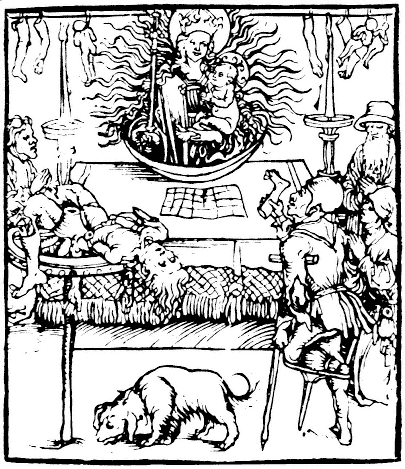
Fig. 1.
Title page of Jacob Isseckemer's 1497 Altötting miracle book, The Little
Book of Mary, God's Mother's Refuge in Altötting.
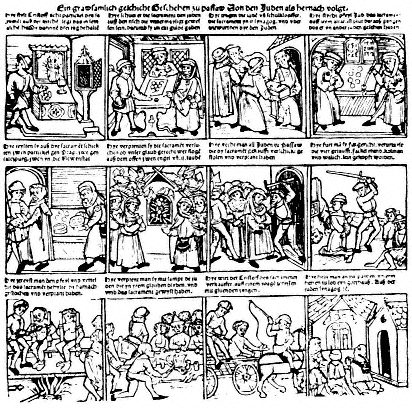
Fig. 2.
A pilgrimage broadside advertising the Passau Bleeding Host miracle of 1478.
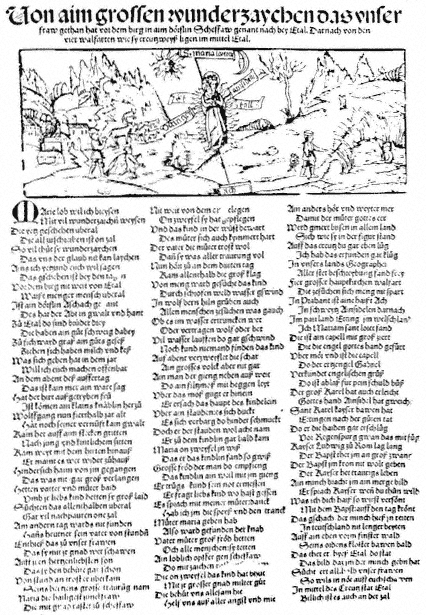
Fig. 3.
The Schöffau miracle broadside of 1517 showing the Virgin floating above an
Upper Bavarian landscape and advertising the pilgrimage to the Benedictine
abbey of Ettal.
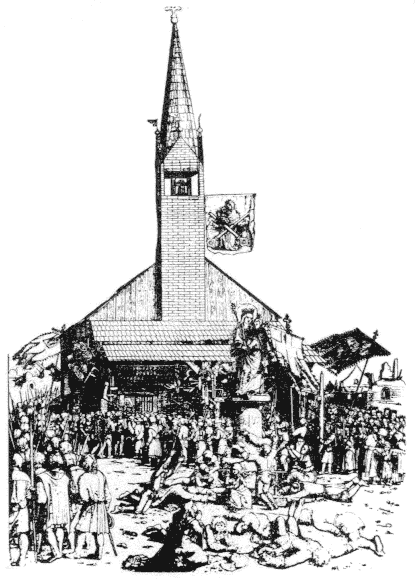
Fig. 4.
Michael Ostendorfer's 1520 depiction of the contemporary events transpiring
at the Schöne Maria pilgrimage in Regensburg.
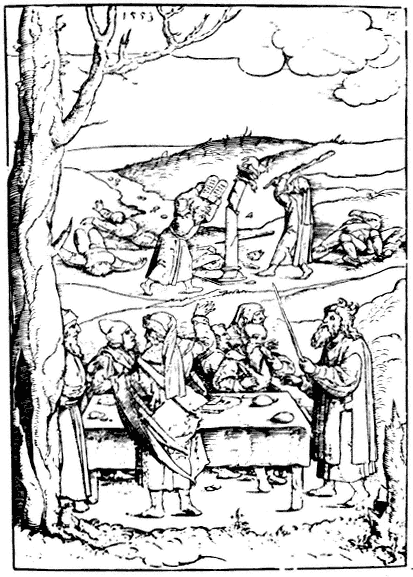
Fig. 5.
Matthias Gerung's "Destruction of the Golden Calf" (ca. 1550), showing the
image installed on a "picture column" (Bildstock ).
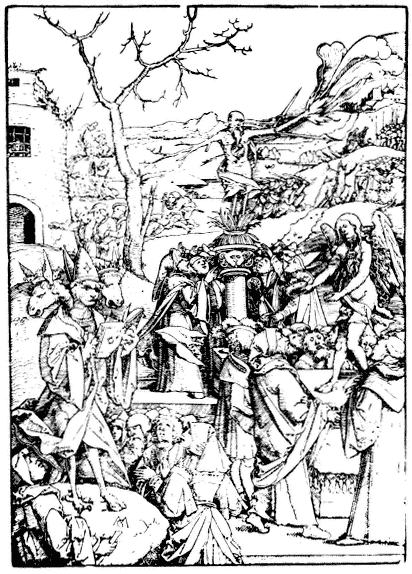
Fig. 6.
Matthias Gerung's "Threefold Idolatry of the Roman Church" (ca. 1550).
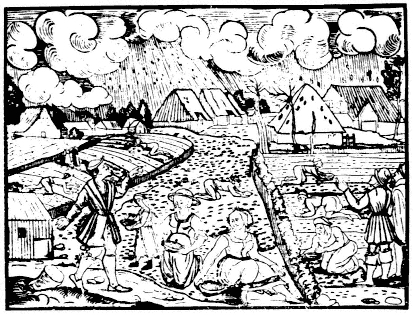
Fig. 7.
A 1570 Augsburg prodigy depicting a shower of grain in Zwipalen and Ried
that occurred on June 14 in that year.
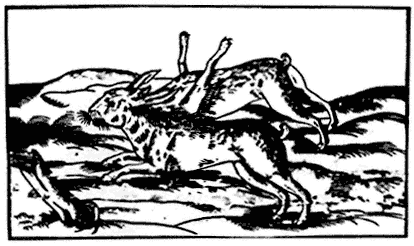
Fig. 8.
The "four-footed" hare. A prodigy printed in Calvinist Heidelberg showing an
abnormal hare caught on 28 April 1583 in the Palatinate.
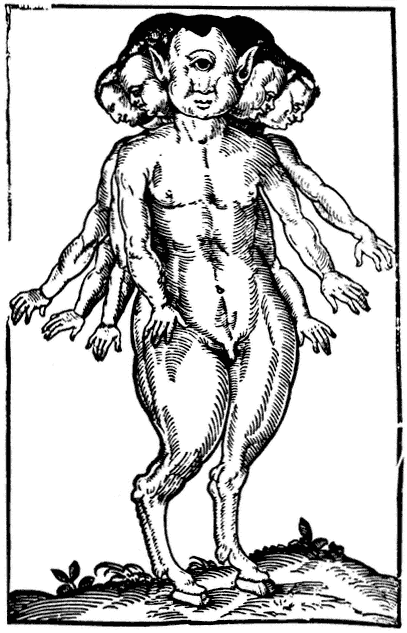
Fig. 9.
A 1578 prodigy printed in Catholic Cologne relating the story of the birth of a
"cyclopslike" boy in the Netherlands.
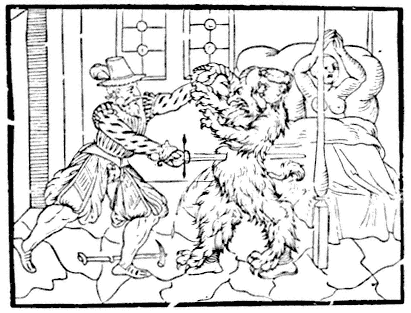
Fig. 10.
A 1569 broadside telling of a Jesuit who tried to frighten a young girl into
relinquishing her faith by costuming himself as a demon.
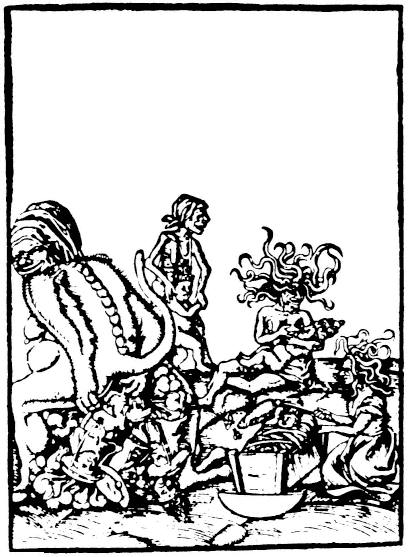
Fig. 11.
Lucas Cranach the Elder's depiction of "The Origins of the Papacy," printed
in Luther's The Papacy at Rome, Founded by the Devil (1545). The work shows
the pope being born of the devil's shit and being suckled and reared by demons.
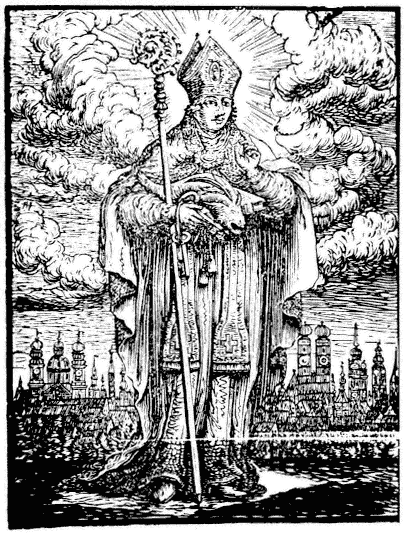
Fig. 12.
A broadside (ca. 1670) showing Munich's recently acquired St. Benno
silhouetted against the city's skyline.
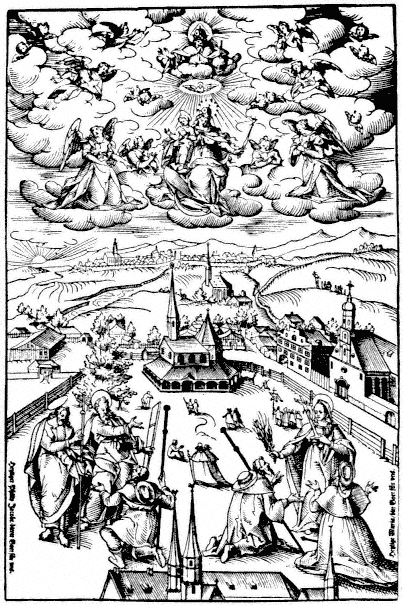
Fig. 13.
A seventeenth-century broadside advertising the Altötting pilgrimage.
The print depicts the central square of the town with its pilgrimage chapel
of Our Lady and the ancient collegiate church of Sts. Philip and James.
In the foreground, all three patrons are shown doling out rewards
to the faithful.
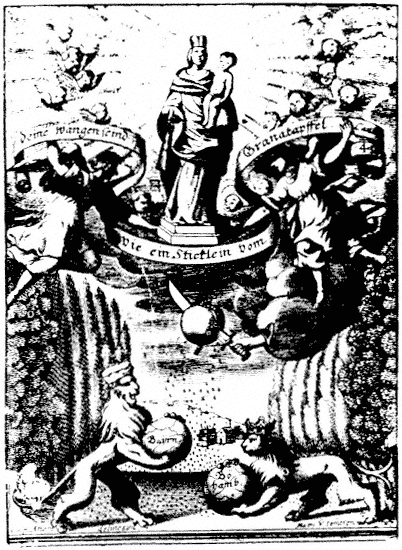
Fig. 14.
Frontispiece to Fortunatus Huber's 1671 Neukirchen pilgrimage book, Ripe
Pomegranate . The print shows the Virgin floating in an ethereal setting
while a knife cuts the pomegranate beneath her. The inscription cites
Canticles 4:3, "Thy temples are like a piece of pomegranate." In the text
Huber explained that it was only by being subjected to the knife that the
Virgin of Neukirchen sent forth the precious garnetlike drops of her blood.
Neukirchen was located in a border region between Bavaria and recently
recatholicized Bohemia, both states being depicted on globes that the
lions present at the bottom of the print. Notice, however, that the Bavarian
globe is placed above that of the once-Protestant Bohemia.